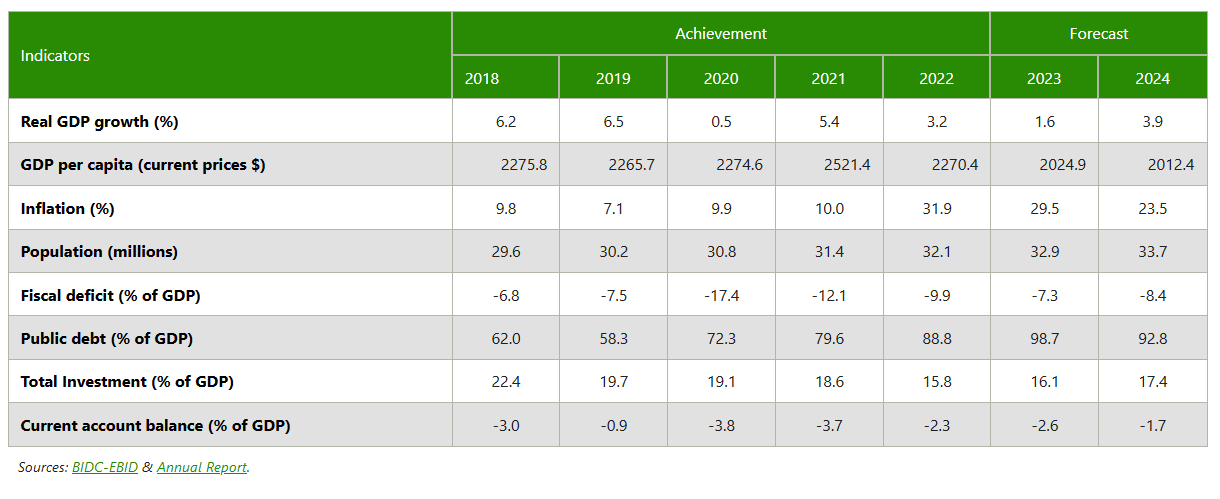
Macroeconomic Performance
Table 1: Overview of some macroeconomic indicators
 Ghana recorded an average growth rate of 4.4 per cent over the last five years. Ghana’s economy grew by 3.1 per cent, down from 5.4 per cent in 2021. The growth of 3.1 per cent was spurred by the services sector, which grew by 5.5 per cent, even though it was lower than the growth in 2021. The industry sector recovered from consecutive declines to a 0.9 per cent growth, buoyed by a 32.3 per cent growth in gold production. Inflation averaged 31.9 per cent, up from 10.0 per cent in 2021, as the cedi depreciated, and food and energy prices escalated. The fiscal balance improved to -9.9 per cent of GDP, while debt-to-GDP widened to 88.8 per cent, with the current account balance improving to -2.3 per cent of GDP.
Ghana recorded an average growth rate of 4.4 per cent over the last five years. Ghana’s economy grew by 3.1 per cent, down from 5.4 per cent in 2021. The growth of 3.1 per cent was spurred by the services sector, which grew by 5.5 per cent, even though it was lower than the growth in 2021. The industry sector recovered from consecutive declines to a 0.9 per cent growth, buoyed by a 32.3 per cent growth in gold production. Inflation averaged 31.9 per cent, up from 10.0 per cent in 2021, as the cedi depreciated, and food and energy prices escalated. The fiscal balance improved to -9.9 per cent of GDP, while debt-to-GDP widened to 88.8 per cent, with the current account balance improving to -2.3 per cent of GDP.
Outlook
GDP growth is projected to decline further to 1.9 per cent in 2023, before increasing to 3.9 per cent in 2024. The decline in GDP growth rate is attributable to a projected decline in the financial services subsector, owing to the debt restructuring, an increase in the cost of production in key industries, owing to the introduction of new taxes, and the contractionary fiscal policy stance, among others. Average inflation is projected to decelerate to 29.5 per cent and 23.5 per cent in 2023 and 2024, respectively. Fiscal balance is projected to improve to -7.3 per cent of GDP due to new revenue-enhancing measures and expenditure cuts. However, the presidential and parliamentary elections in 2024 and the payment of interest on external debt are expected to drive fiscal balance up to -8.4 per cent of GDP. Ghana’s debt position is projected to reach 98.7 per cent of GDP in 2023 and decline to 92.8 per cent in 2024. The current account balance is projected to improve to -2.6 per cent of GDP and -1.7 per cent of GDP in 2023 and 2024, respectively.
Probable Headwinds
Having secured the IMF Board approval for the Extended Credit Facility programme, with an initial disbursement of just over US$600 million, Ghana is set to reduce its debt to within sustainable limits, through the restructuring of the external debt and fiscal consolidation. Headwinds related to currency stability, fiscal slippages and labour unrests continue to loom large. The payment of matured coupons and principals for debts outside of the Domestic Debt Exchange programme will have adverse implications for fiscal balance. In contrast, the country’s ability to settle foreign currency-related debt service costs will be put to the test.

